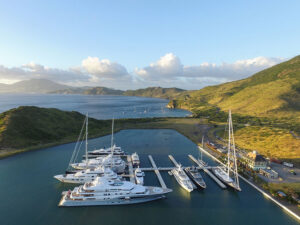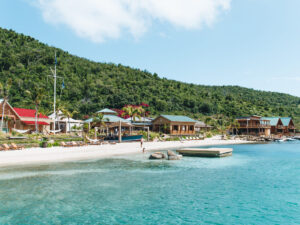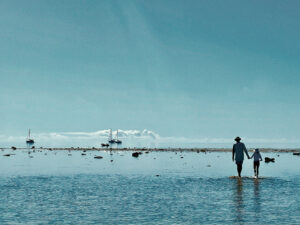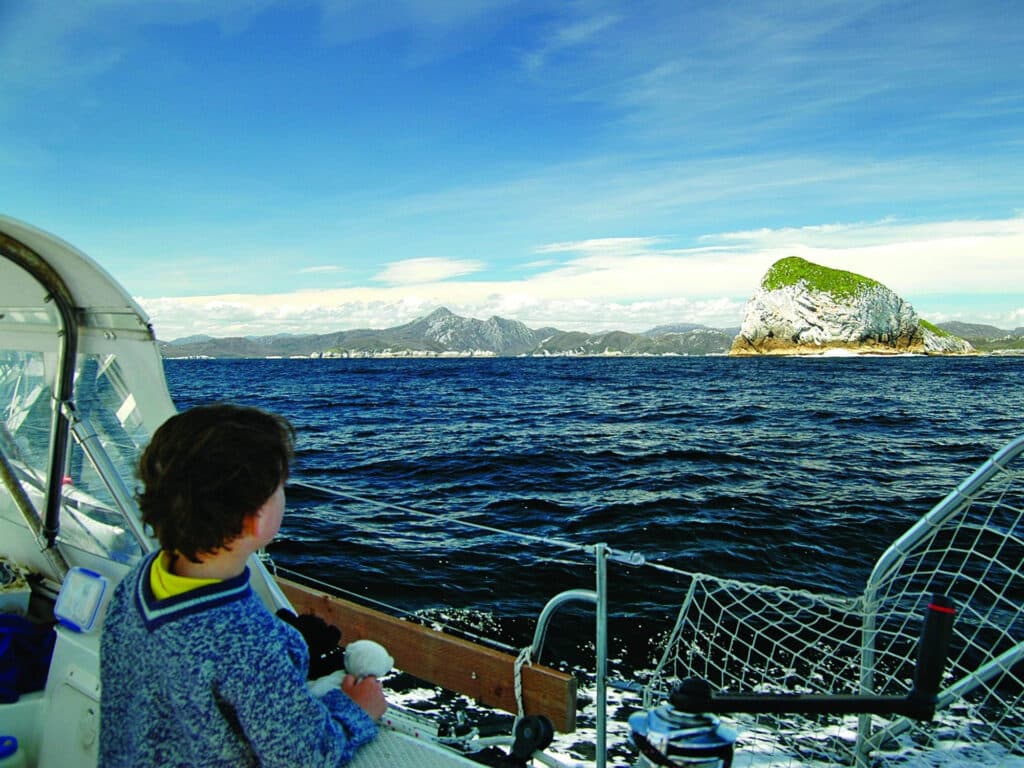
From the mountain summit we looked down at Galactic, the 45-foot cutter that is my family’s home, and at the 35-foot catamaran Take It Easy, our only neighbor in the anchorage far below. From this perch we could see all the places that were familiar to us from studying the chart of Port Davey, the grand cruising destination of southwest Tasmania. But instead of the two-dimensional shapes on the chart, the bays and narrows of the inland waters were revealed as part of a three-dimensional landscape, surrounded and partitioned by ancient, folded mountains. Not far off we could see the open sea, where the Indian and Pacific oceans meet in the Roaring 40s.
It was a clear, windy day, and 40-something-knot gusts had the two boats dancing around the anchorage. Wade and Chris, the Australian owners of Take It Easy, shared my uneasy feeling — it was time to get back to the boat. So we started down. And then things got weird. It began as a dark cloud. Which was odd, as it was a clear day. The cloud got darker, and lower. And it was red-brown, not cloud-gray. Wade and Chris confirmed what I’d started to suspect.
“Bushfire,” said Wade. We picked up speed. Whatever was about to happen would be best appreciated from our boats.
Our cruise to Tasmania’s Port Davey was my family’s final voyage in Australia, and it was fitting to end our time Down Under with a bushfire. I mean, why not? Our first taste of these Australian waters four years earlier was a shark attacking our boat. At night. A hundred miles offshore.
What a continent.
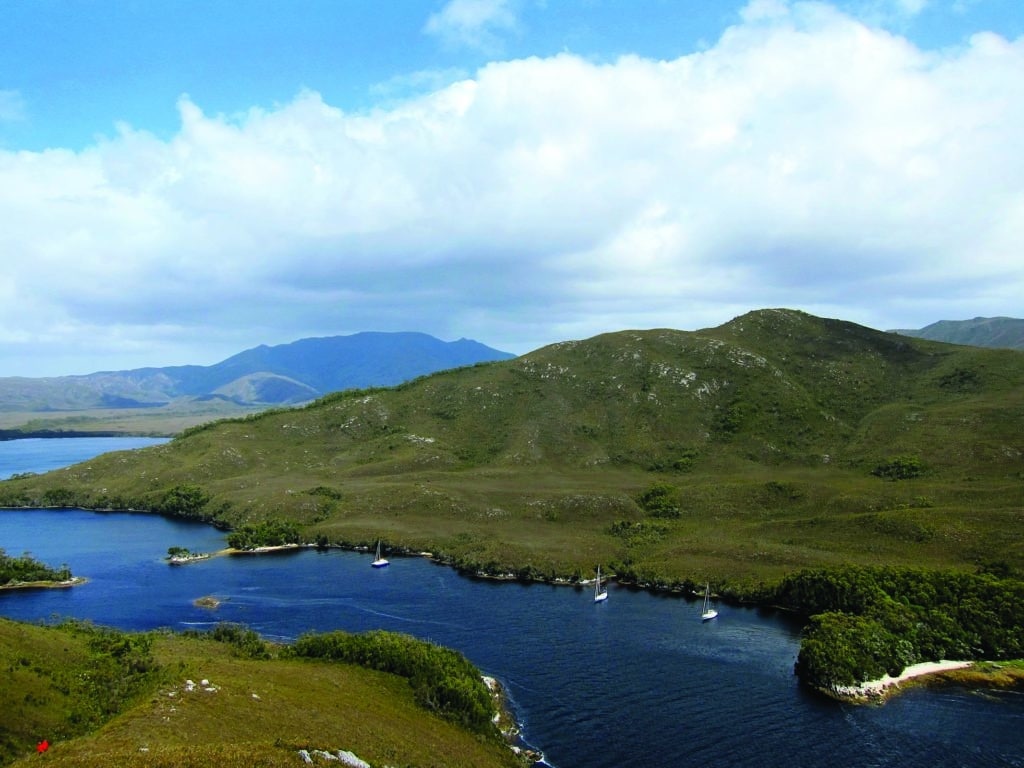
When we first sailed to the island state of Tasmania, we were a crew of three: me; my wife, Alisa, six months pregnant; and our 3-year-old son, Elias. We were looking for a place to base ourselves for two big transitions coming our way: the birth of our second son, Eric, and a boat swap, from Pelagic, our dear old Crealock 37, to a new ride for a family of four. Pelagic had an open plan below, and after three years of sailing the Pacific with a toddler while paying our way by doing scientific research on my laptop, I was dreaming of an adult cabin and a children’s cabin, as far apart in the boat as possible.
“Doors,” I said to Alisa. “This family needs doors.”
So when we arrived in Hobart, our expectations were high — we were hoping to use the city as our base for a year. We’d never been there and knew no one.
Mainland Australia is friendly, but Tasmania is in a different league. In our first week, we had people over to the boat for dinner or went out to someone’s house five of the seven nights. Two couples threw a barbecue so we could meet all their friends and start to feel at home. After the dust settled on that first week, we knew we’d landed in the right place. When we bought Galactic in California a year later, we spent three months getting her ready, then put 10,000 happy miles under our keel wandering back to Hobart.
We spent another year in Tasmania, giving Elias, now 5, the chance to attend school. During his vacations we explored the sailing delights of southeast Tasmania. Hobart, we found, is surrounded by world-class coastal cruising. While there is a rich history of sailing there, the anchorages remain uncrowded today.
The area is beautiful and unique, and we had good friends with boats and young kids to share our adventures. For all these reasons, we fell in love with Tasmania, and even thought about staying.
But in our hearts we knew that we hadn’t sailed away from Alaska to settle down in Hobart. We began to make plans to leave. And before we left, we knew that we had to visit Port Davey.
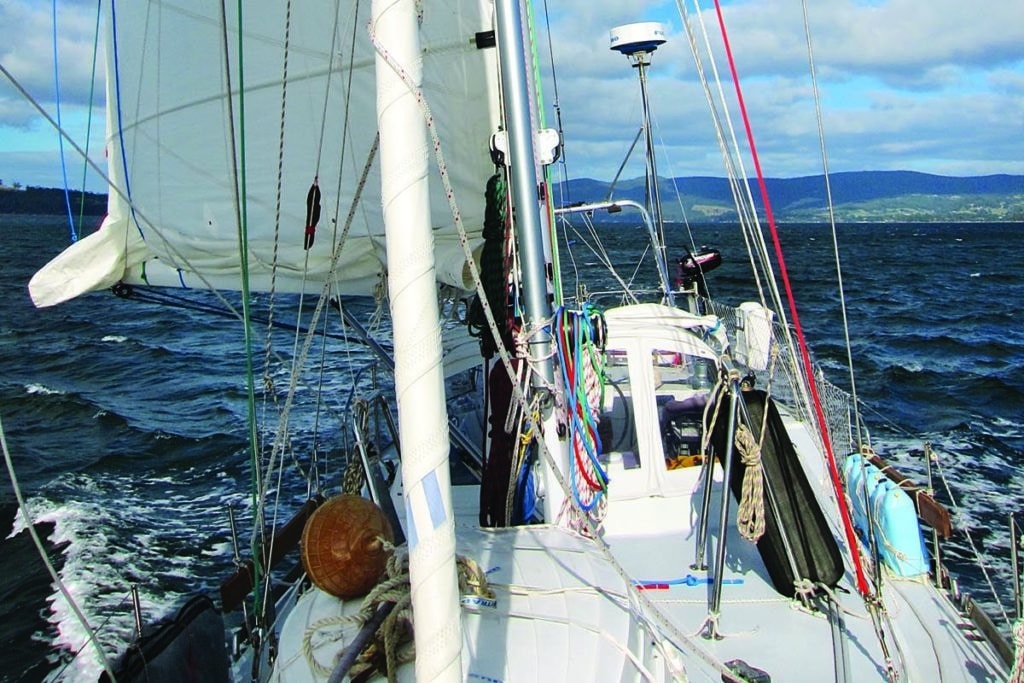
Wherever sailors are knocking around on boats, there’s some mythical, distant destination people talk about — the place that’s hardest to get to and more beautiful than anywhere else. In Tasmania, that place is Port Davey.
It’s definitely hard to get to; there are no roads in southwest Tasmania, and sailing there means braving the rugged south coast and the westerlies of the Roaring 40s. We’d heard it was beautiful too, and that it had an attractive history in the recent pioneering past of Tasmania. Who wouldn’t want to go?
On the day after Christmas we found ourselves raising the anchor in Recherche Bay, the jumping-off point for Port Davey. The forecast was for a one-day break in the west winds, and we were underway at 0400 to make the 70-mile passage.
As the day dawned, the rugged south coast of Tasmania was slowly revealed to us. In the distance we saw two other boats headed toward Port Davey — Take It Easy and our friends John and De on Silver Air. As we traveled farther west, the coastline got rockier and took on a delightful chalk-white color, thanks to quartzite in the cliff faces. Elias played, I read aloud, and Alisa baked bread to go with the leftovers from our holiday feast. Everyone was happy.
Well, nearly everyone. The little wind and swell we did have were dead on the bow. It was too much for Eric, who drew the short straw when it comes to seasickness. He settled into being miserable in his mother’s lap for the afternoon, toughing the day out until it was done.
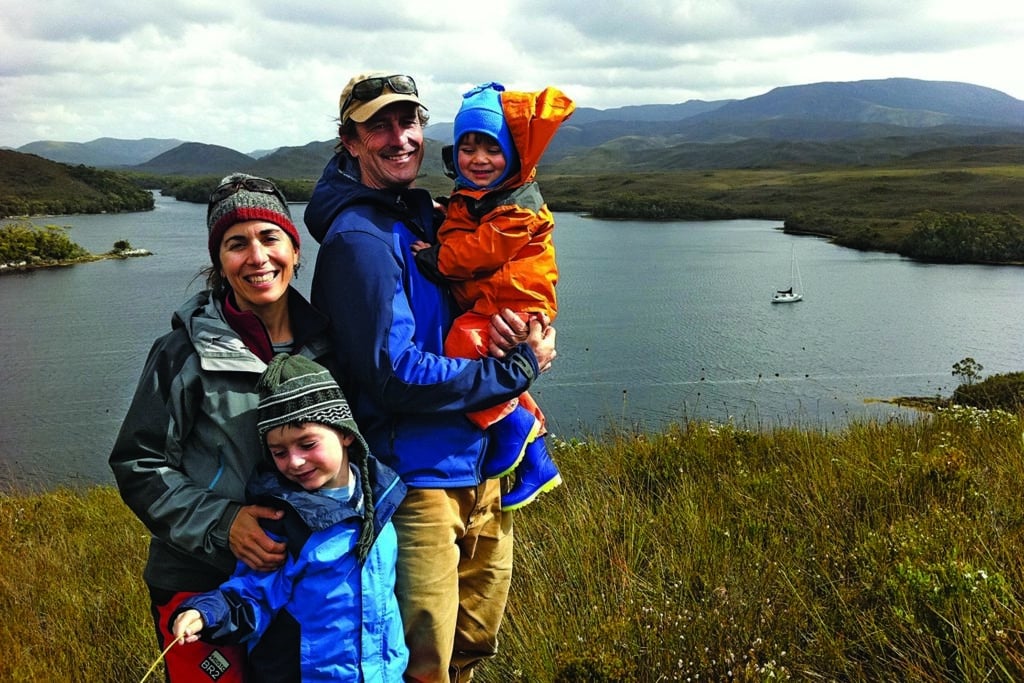
We made the turn around South West Cape, the very southwest corner of Tasmania. The cliffs grew whiter and the sky got bluer — that peerless blue of the ocean-rich Southern Hemisphere. Meanwhile the treeless hills had an ocher-green color emblematic of the Southern Hemisphere’s higher latitudes — a color out of the 1950s National Geographics I used to read at my grandparents’ house, and which I only now recognized as I saw it with my own eyes.
As we dropped the anchor in Bond Bay, in the north arm of Port Davey, the silence was perfect. There was no evidence that there was anyone within 10 miles of us. We had that blessed feeling of having one of the finest corners of the world to ourselves. It’s times like this that have kept us sailing the Pacific year after year.
We explored the outer waters for two days, but when the weather deteriorated, we decided it was time to move to the place that makes Port Davey famous: the inland waters of Bathurst Channel and Bathurst Harbour. We moved on a leaden day with a rising wind, suitably dramatic conditions for entering such a spectacular waterway. At first I saw a continuous wall of mountains where the channel was meant to be. Then we came around the Breaksea Islands, and a gap appeared in the shore — by all obvious signs, a shallow cove in the coast. As we got closer the cove opened up, and suddenly we were looking down a narrow slot, a passage back into the interior, which promised secret delights to be explored. Only 600 yards of water separated the mountains on each side, but we had a fortune of water under our keel, 14 fathoms or more.
We watched the scenery spool by, a fairyland of miniature mountains given scale and gravitas by the way trees struggle to grow over most of this wind-dominated landscape. We also considered the weather; in Tasmania, you must always consider the weather. An approaching front promised hard northwesterlies going to harder southwesterlies, with associated gloom and rain. We pulled into little Casilda Cove, the banner bad-weather anchorage in the area. The coming winds were meant to barely reach gale strength, so we could anchor most anywhere, but there was something attractive about the cove, where you tie to the shore and let the winds whip overhead, Patagonia-style. Port Davey is beautiful unto itself, a delightful little corner of the world, but it’s also something of a theme park for Southern Ocean sailing. The mountains are small, the anchorages are close together and secure, and everything is on a miniature scale when compared to someplace like the Chilean fjords. The wind blew like stink, but the protection was so perfect that we tied stern-to as a diversion rather than a survival strategy.
Silver Air was already tied in, and De gave Alisa a hand getting our lines up the high bank and tied to trees. Take It Easy motored in and tied in farther up the inlet. The break in the westerlies had lasted only for the one day that we three boats had transited the south coast, and anyone who was in Recherche after that would likely wait weeks for the next break. For the foreseeable future, Port Davey would be a private wonderland for our three crews.
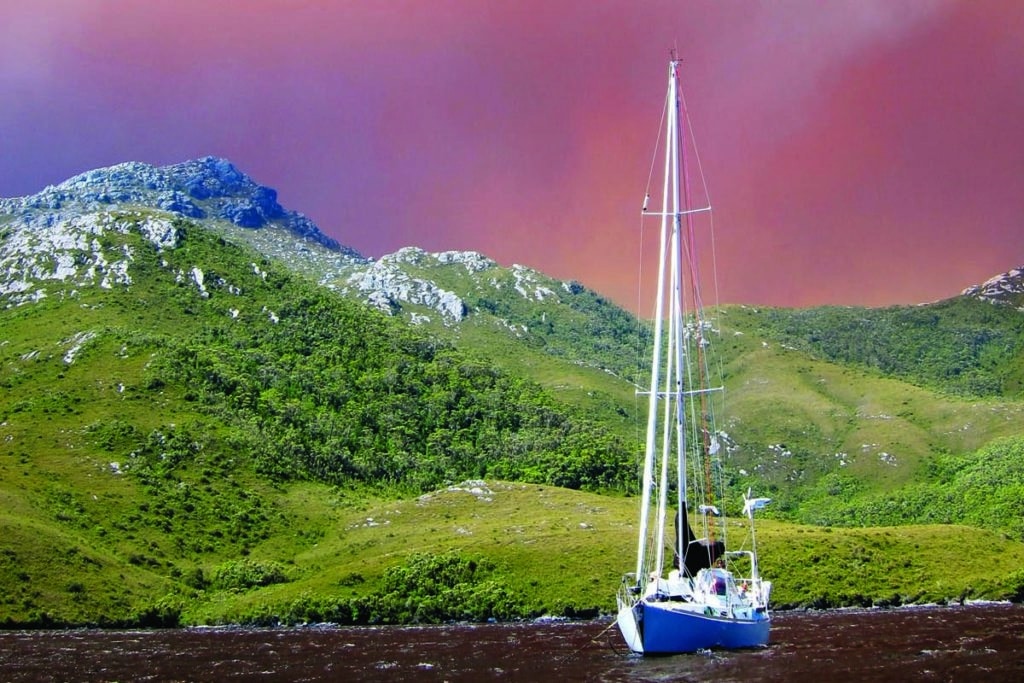
The next day saw rain on deck and cold below. But the boys had their Christmas presents to play with, and Alisa and I generally like rainy, windy anchorages. It must be the Alaskans in us. We reveled in the condensation on the portlights, the way the stern lines went taught in the gusts, and the cups of hot chocolate all around. We had all we wanted.
When the weather improved, Elias and I made our first-ever father-son mountain climb up Balmoral Hill, a perfect little Matterhorn of a peak. Then, after exploring the local beaches and tide pools, we cast off the stern lines and motored toward Bathurst Narrows. The lens of fresh water resting on top of the salt water was giving our sounder the fits, and the tannin-rich waters from the surrounding buttongrass plains were impossible to see through. There were few dangers and the chart was excellent, but the mystery of not knowing exactly what was going on beneath the surface kept me on alert.
We threaded the narrows beneath the rocky outcrops of Mount Rugby. To starboard were gentler slopes, promising good family walking. Before we explored those, though, we pulled into the shallow bowl of Bathurst Harbour and then around the corner, literally, to the anchorage at Clayton’s Corner.
We chucked out the hook, then dressed Galactic in fenders. We were expecting company.
On schedule, a tour boat came roaring out from the airstrip at Melaleuca Inlet, bearing day-tripper tourists on a whirlwind visit to Bathurst before they flew back to Hobart. The boat pulled alongside, and our friend Mary-Anne Lea stepped aboard to stay with us for a few days. Mary-Anne is a biologist with a keen appreciation for the natural history of Tasmania, and her visit enlivened our experience. Together we enjoyed the cycle of weather that came to dominate our visit. At first the days were fine, and we hopped from anchorage to anchorage and hiked the hills. When the weather made the inevitable turn, it was conveniently New Year’s Eve, and we celebrated belowdecks with homemade paper crowns and Alisa’s famous boat pizza while Galactic tugged against the anchor chain.
By the time I got back to Galactic, the sky was apocalyptic.
All too soon Wade and Chris were kindly ferrying the entire Galactic crew up the glorified ditch of Melaleuca Inlet aboard Take It Easy, to the airstrip for Mary-Anne’s flight back to Hobart. The cruising guide suggested that we would have likely been able to get Galactic‘s 6-foot draft up the twisting inlet, but I was happy not to try.
Back on Galactic, we started to make our way back toward the coast — our time was drawing down. But we stopped for family hikes along the way, and Wade, Chris and I took a day to hike up Mount Rugby. That’s when the fire made itself known.
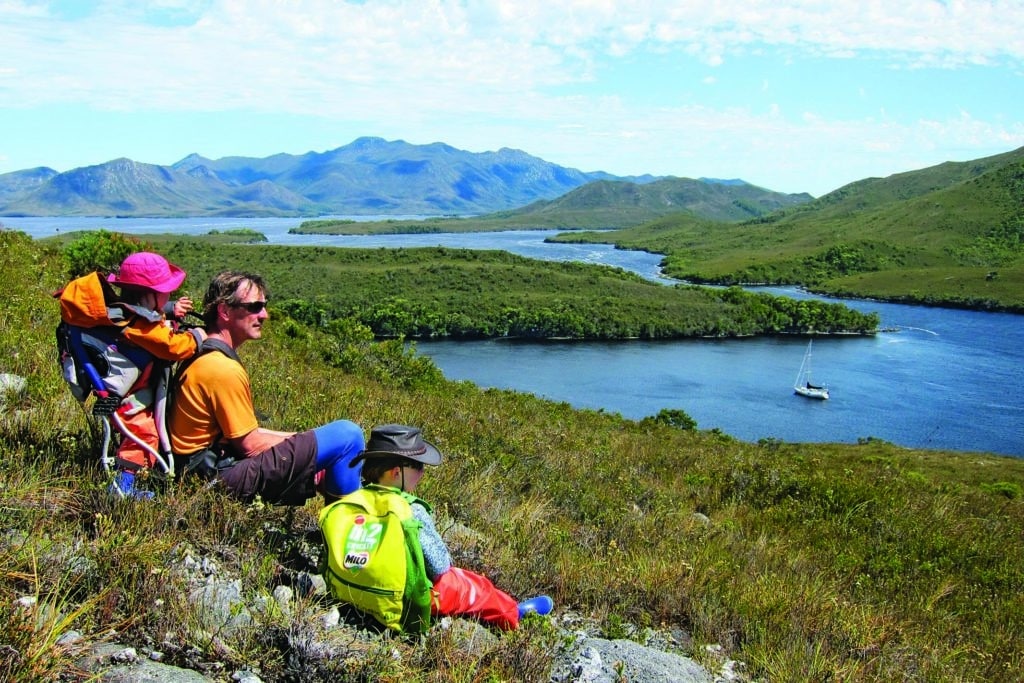
Elias and I stood on the bow, watching waves of smoke cresting and pulsing overhead and holding out our hands to catch bits of drifting ash. It was a dry day, with the wind still gusting above 40 knots. Silver Air, having been defeated in the search for a secure anchorage out near the entrance, steamed back to join us. No harm came to us, but the fires burned day after day, and the smoke was with us for the rest of the trip, the amount varying only with the direction of the wind. At night we saw sullen flames on the distant hills.
After eking out one final hike to the spectacular outer-coast beach of Stephens Bay, we found ourselves again rounding South West Cape, this time heading east, back to Hobart.
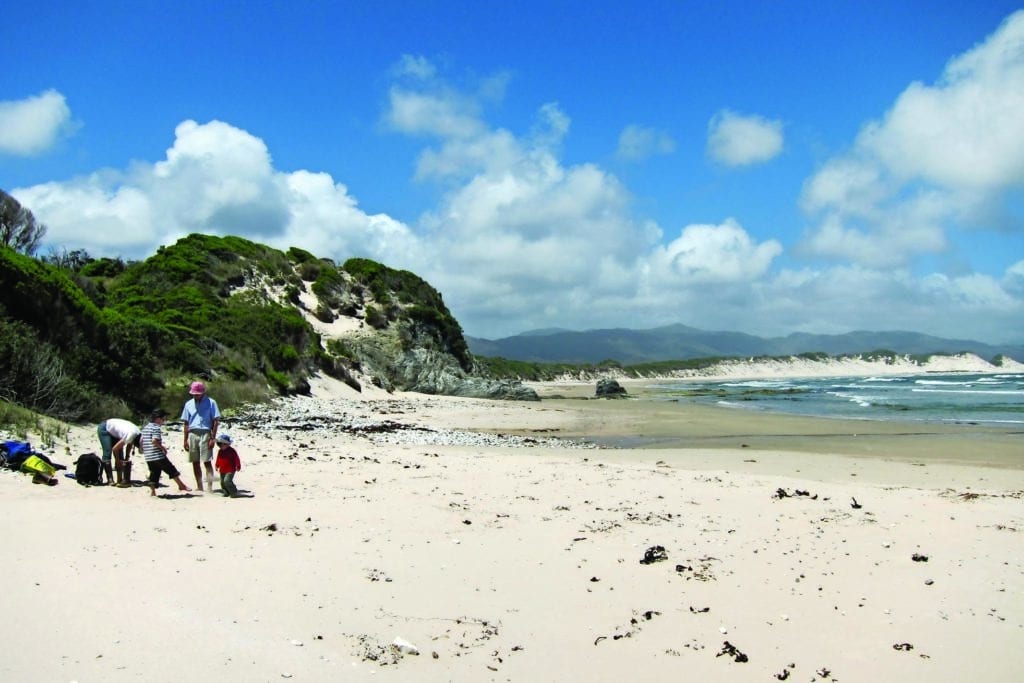
Suddenly four years of our lives had gone by, in Hobart and the intervening year of sailing back from California. Elias now speaks with a discernible Australian accent, courtesy of his school year in Hobart. For the rest of his life, Eric will say “Tasmania” when anyone asks him where he was born. We’ll always have a unique connection to this place. We’d been lucky, as travelers, to find it. But traveler’s luck only holds if you keep moving.
While our voyaging friends migrated onward to the Indian Ocean, our delicious fate seemed to be staying in the Pacific. Since we’d run out of Pacific in this direction, it was time to turn around and see what the temperate southern latitudes had to offer us. In a few weeks we headed still farther east, across the Tasman Sea to New Zealand and the sub-Antarctic islands.
New places forever wait.
Mike Litzow is the author of South from Alaska: Sailing to Australia with a Baby for Crew.

